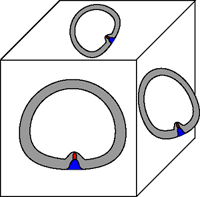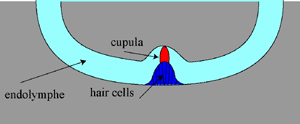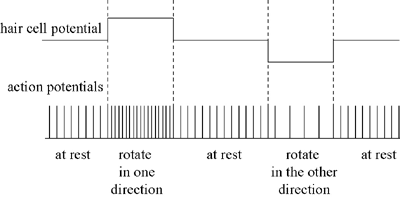C. The Semi Circular Canals:
1. The semi circular canal: This is a canal that is filled with endolymph. The canal is circular which means that the fluid can move in a circle. At one end of the canal, there is the crista ampullaris that detects the movements of the fluid and pass on that information to the vestibular nerve. |
|
2. The orientation of the three semi circular canals. The three canals are oriented in three different directions and at right angles to each other. Like the three faces of a cube: one is at the front plane, one at the side plane and the third at the top plane. In this way, rotation at any angle can be picked up by one or two canals.
|
|
3. The crista ampullaris: As in the macula, there are hair cells in the bottom of the canal. The hairs are fixed to a "cupula" (= sort of a hat) which is a gelatinous mass. This cupula can turn left or right, depending on the flow of the endolymph. |
|
4. How does it work? When the head starts to rotate, the bone (=skull), and therefore the canal will also start rotating. But the endolymphe, due to its inertia, will not move immediately. So, if the head rotates in direction a, then the fluid, which lags behind, will flow in the opposite direction (b). This fluid flow will push the cupula to bend to the left (c). If the head rotates in the opposite direction, then of course, the fluid will also flow in the opposite direction and the cupula will bend to the right.
|
 |
5. Frequency Modulation: As in the saccule and utricle, it is crucial to know whether the head its rotating to the right or to the left. Therefore, in a similar way, there is a system of modulating the intracellular potential to action potential frequency. Thus, rotation in one direction will increase the (resting) frequency whereas rotation in the opposite direction will cause a decrease in the resting frequency. |
|



